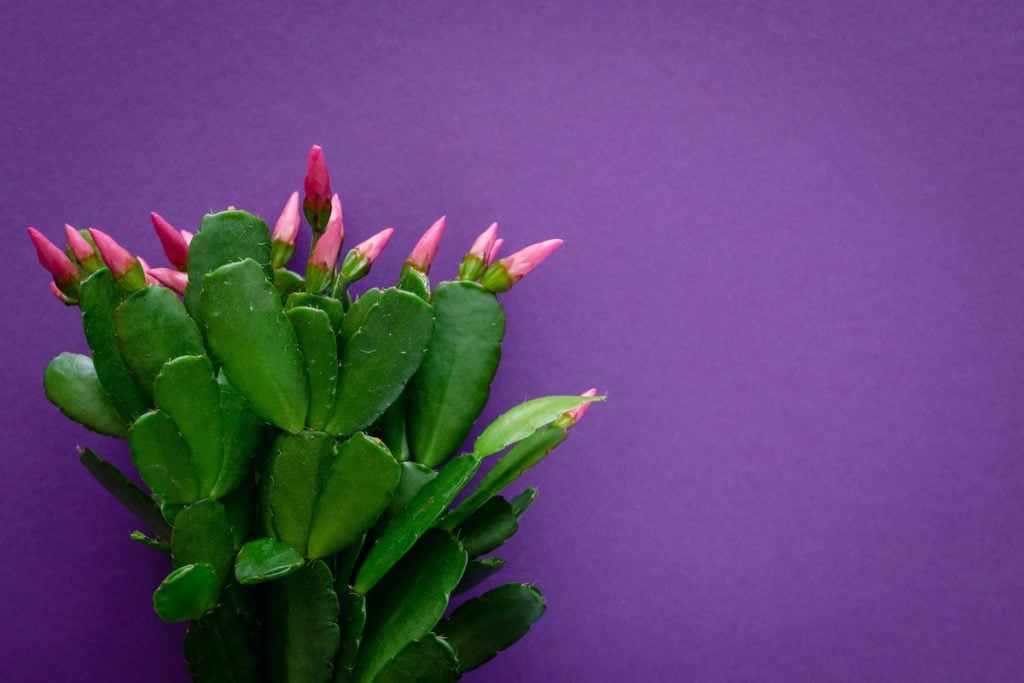Easter Cactus: Tips For Growing And Getting Beautiful Spring Blooms
These tips will help you care for your potted Easter cactus and get colorful blooms long after the holiday is over.

Holiday cacti, such as the Thanksgiving cactus or Christmas cactus, are some of the most popular, unique, and beautiful houseplants. They’re easy to care for and when those delicate blooms appear around the holidays, it’s magical. But did you know there’s also an Easter cactus that produces colorful, cheerful blooms? The Easter cactus (Hatiora gaertneri, formerly known as Rhipsalidopsis gaertneri), or “spring cactus” as it is also called, has flowers that typically bloom—you guessed it—in spring, around the time of Easter. The lovely star-shaped flowers open at sunrise and close at sunset, and come in a variety of colors—brilliant orange, violet, fuchsia, white, or red—to brighten your home just when you need it.
A Tropical Cactus

When we think of “cactus” we immediately think of the prickly variety that are native to arid desert climates. But Easter cacti are native to the tropical rainforests of Brazil. In their natural environment, they grow in the crotches of tree branches but they do not damage or take anything from the host tree, so they are not parasitic.
How The Easter Cactus Is Different From Other Holiday Cacti
If you want to know which cactus you have, simply look at the leaves.

While most Christmas and Thanksgiving cacti are labeled incorrectly, there’s a good chance you won’t have that problem when purchasing an Easter cactus.
Caring For Your Easter Cactus
Understanding how the Easter cactus grows in its native environment can go a long way in giving it the best care. The roots do best when they can breathe, so plant them in a loose soil where water and oxygen can easily reach the roots but also drain well. They need more frequent watering than desert cacti but they do well in partial sunlight and dry conditions. Don’t place in a hot window or in direct sunlight.
Water your Easter cactus well, and allow the water to drain out of the pot afterwards. The soil should be dry to the touch before you water the plant again. This helps prevent the roots from rotting. During spring blooming, the plant may need more water than it does at other times. You’ll also want to place a saucer under the pot and add a layer of pebbles between the pot and saucer to provide humidity and prevent the stems and roots from sitting in any excess water.
Easter Cactus Repotting Tips

If you purchase an Easter cactus in the spring, it is most likely already flowering. This cactus should thrive long past its first blooming season. In fact, just like other holiday cacti, it is not uncommon for them to grow for ten years or more.
If you received an Easter cactus as a gift, it may have come in a plastic container. We recommend repotting it. But it’s best to wait a month or two after the spring blooming has stopped. Clay pots are ideal for growing Easter cactus as they allow for good soil aeration and drainage. Use a potting mix suitable for growing succulents or cacti; one that drains well. Light peat mixes also allow proper drainage. You can also add perlite or bark pieces to the potting mix, if it seems too heavy. Easter cacti like to grow snug in its pot, so you probably won’t need to repot it again for a few years.
Should You Fertilize Your Easter Cactus?
Fertilizing enhances plant growth and flowering. Wait a month or so after the blooming season to fertilize your Easter cactus. Use a basic soluble houseplant fertilizer two to three times a year in the spring and summer months, if desired. Or you may add organic compost every spring to the pot instead.
Pruning Tips
Pinch dead flower blooms off as they appear. Pruning isn’t a must unless you want to control the overall size of the plant. Once the plant has reached maximum desired size, trim the outer leaflets of the entire plant to maintain its shape and size.
How to Get Your Easter Cactus to Bloom
Your Easter cactus need equal amounts of dark and light for eight weeks prior to their spring blooming season. At night, aim for cooler and drier conditions, ideally around 50˚F. And while these plants like the warmth, don’t place your potted cactus near any direct heat source. The warmer your house, however, the sooner the blooming period begins. Like other holiday cacti, you may even get blooms twice a year!
Another bonus: they are considered nontoxic to curious pets, which make the Easter cactus and ideal year-round houseplant.

Deborah Tukua
Deborah Tukua is a natural living, healthy lifestyle writer and author of 7 non-fiction books, including Pearls of Garden Wisdom: Time-Saving Tips and Techniques from a Country Home, Pearls of Country Wisdom: Hints from a Small Town on Keeping Garden and Home, and Naturally Sweet Blender Treats. Tukua has been a writer for the Farmers' Almanac since 2004.






So my cactus, suddenly started dropping her leaves. She is healthy. Beautiful. Never has this happened before. Not overly wet. And not dry. I’m baffled. Any help would be appreciated.
They are cactus, they do not have leaves, those are stem segments, if you are going to write about something know what youo re talking about before yoou tell others.
…whatever…
Just ignore rude people!
No need anyone to be rude and disrespectful.. just give correct information and move forward!
come come now Children